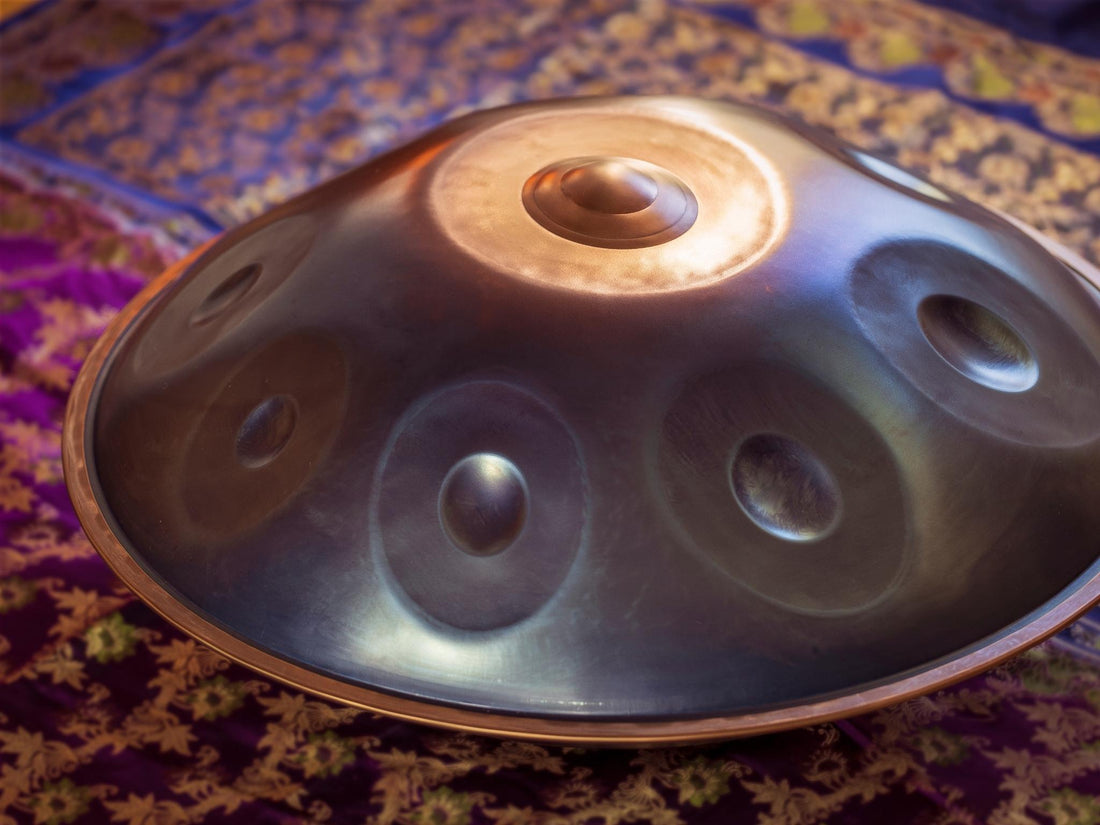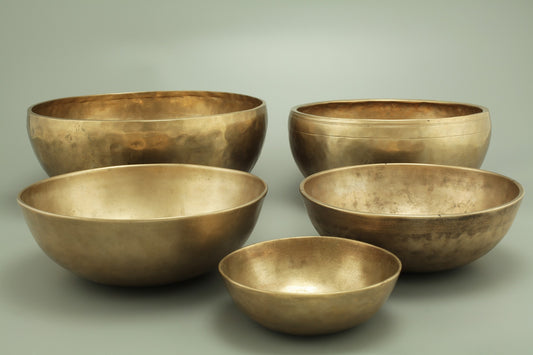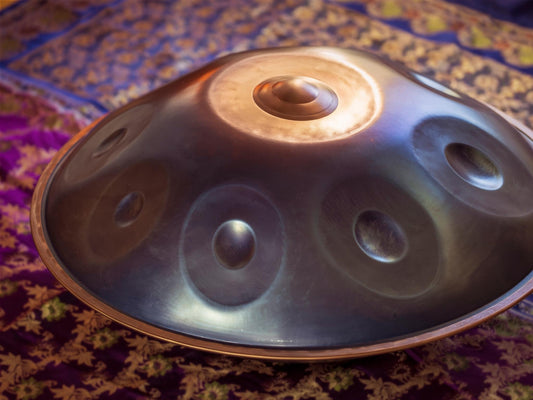Whether you’re an experienced musician who has recently discovered the handpan drum or someone who has heard handpan music and wants to learn more, the handpan drum is a simply wonderful instrument that can bring inner peace through hypnotic notes and relaxed vibes.
This quick guide will answer all of your questions regarding handpan music, such as;
- What is the handpan drum?
- Where did the handpan drum originate?
- How many notes does a handpan have?
- What is handpan music used for?
- What are the different types of handpan?
Let’s get started.
The History of the Handpan Drum
The handpan drum is a relatively new musical instrument that is an offshoot of the steel pan drum. It was created in 2000 by Swiss pair Felix Rohner and Sabina Scharer. Also known as the ‘hang’ its name derives from the Bernese German word for hand. Other names include Pantam, hand drum, and hang drum. The latter is technically incorrect while the makers state that it should only be referred to as a ‘hang’ rather than a handpan.
Rohner and Scharer’s company PANArt Hangbau AG publicly launched the instrument in 2001. Its hypnotic sounds are reminiscent of the Caribbean steel pans while it simultaneously carries a host of unique features - not least due to its design, which features two steel half-shells that are glued together to form a 25cm (height) by 54cm (width) drum that looks somewhat like a UFO.
The instrument features eight notes that are arranged around the face in a zig-zag pattern. The low note is known as the ding while the instrument is available in several scales. It is an invention that comes following 25 years of research into the steel pan instruments and their incredible sound.
Unlike a standard steel pan drum, the hang is made using materials of a consistent thickness. However, Rohner and Scharer stopped production of their original instruments in 2013 to help protect their exclusivity and mystique. The sounds produced are often referred to as woody and with audible overtones.
The Different Types of Handpan
Working from a small production factory, the two makers only create a small number of handpans each year. As such, all original handpan hang drums are signed and numbered. The original launch was manufactured in multiple scales ranging up to 45 different sound models.
Since launching the first generation in 2001, the creators have released a Low Hang feature a ding of F3, E3, or E♭3. A second generation featuring a surface coating of annealed brass followed. In 2008, an Integral Hang - which offers the seven tone fields of D3 Ding, A3, B♭3, C4, D4, E4, F4, A4 - was released.
While the term Hang has been trademarked by the company, a host of additional instruments classified as handpans have been introduced by other manufacturers. They are all variants of the percussion instrument.
Why Handpan Music?
By now, we can all appreciate the amazing benefits that listening to relaxing music can bring. However, playing handpan music can take the enjoyment to a whole new level. The handpan can be played as a standalone activity or incorporated into meditation and yoga.
The rounded design and ability to produce sounds and vibrations in all directions make this type of music very effective for sound healing purposes. The human brain enjoys simplified frequency ratios, which are naturally produced by the handpan’s 1:2:3 frequency ratio. A combination of calming harmonies and vibrations works wonders.
Handpan music is also very therapeutic thanks to the captivating and hypnotic tones. Whether listening alone or within a group setting, the inner peace and relaxation of the Trinidad-inspired sounds can help alleviate stress.
In turn, playing handpan music is a great tool for establishing increased mental wellness in our hectic modern lives.
While listening is deemed calming, playing can take the benefits of the handpan to a whole new level.
If your looking for Handpan Music, Check out our Handpan Music, Vol. 1 below:
How to Play the Handpan Drum
One of the great things about the handpan is that it is a percussion instrument which is suited to players of all experience levels. Drums are generally considered one of the easiest instruments to learn. Even if you do not understand the musical notes, playing a basic rhythm shouldn’t be too hard. Meanwhile, the layout of the handpan makes it a relatively simple job to build different pitches. Once mastered, the handpan drum is capable of producing some incredible tunes that carry the unique flavor.
If you have prior experience of playing traditional steel drums, it should translate to easier learning curves for the handpan. Nonetheless, it is a distinct instrument and players must respect this. Online courses can help handpan players of all experience levels unlock the full potential of this music style.
The handpan is commonly played by placing it on your lap. However, it may additionally sit in between your legs while sitting on the floor or on a table while sitting on a chair. To play the instrument, you must hit one of the dimples (which are tuned to a diatonic scale) that are found around the top-facing shell. As the name suggests, the handpan is primarily played with the hands, although mallets and similar items can be used too.
When a dimple is struck, the vibrations resonate in between the two shells before the air is forced out through a hole in the bottom half of the shell to create an amplified sound. This is where the mechanics are vastly different from steel pan drums and gain their distinct tones.
The Final Word
Handpan instruments are still very much in their infancy but they build on musical elements that have been used in recreational and tranquil settings for centuries. The hang is perfect when wanting to use the power of music to relax the mind, body, and soul.
However, if you can’t get your hand on one of the elusive originals, handpans from other manufacturers will deliver the perfect solution. Best of all, it’s an instrument that’s easy to play but takes years to master. A lifetime of relaxed enjoyment is assured.





